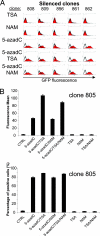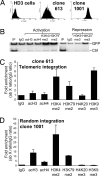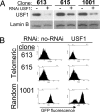Protection against telomeric position effects by the chicken cHS4 beta-globin insulator
- PMID: 17715059
- PMCID: PMC1955792
- DOI: 10.1073/pnas.0704999104
Protection against telomeric position effects by the chicken cHS4 beta-globin insulator
Abstract
Epigenetic silencing of genes relocated near telomeres, termed telomeric position effect, has been extensively studied in yeast and more recently in vertebrates. However, protection of a transgene against telomeric position effects by chromatin insulators has not yet been addressed. In this work we investigated the capacity of the chicken beta-globin insulator cHS4 to shield a transgene against silencing by telomeric heterochromatin. Using telomeric repeats, we targeted transgene integration into telomeres of the chicken cell line HD3. When the chicken cHS4 insulator is incorporated to the transgene, we observe a sustained gene expression of single-copy integrants that can be maintained for >100 days of continuous culture. However, uninsulated single-copy clones showed an accelerated gene expression extinction profile. Unexpectedly, telomeric silencing was not reversed with trichostatin A or nicotidamine. In contrast, significant reactivation was obtained with 5-aza-2'-deoxycytidine, consistent with the subtelomeric DNA methylation status. Strikingly, insulated transgenes integrated into telomeric regions were enriched in histone methylation, such as H3K4me2 and H3K79me2, but not in histone acetylation. Furthermore, the cHS4 insulator counteracts telomeric position effects in an upstream stimulatory factor-independent manner. Our results suggest that this insulator has the capacity to adapt to different chromatin propagation signals in distinct insertional epigenome environments.
Conflict of interest statement
The authors declare no conflict of interest.
Figures






Similar articles
-
Gene specificity of suppression of transgene-mediated insertional transcriptional activation by the chicken HS4 insulator.PLoS One. 2009 Jun 18;4(6):e5956. doi: 10.1371/journal.pone.0005956. PLoS One. 2009. PMID: 19536296 Free PMC article.
-
Loss of transcriptional activity of a transgene is accompanied by DNA methylation and histone deacetylation and is prevented by insulators.Genes Dev. 1998 Sep 15;12(18):2852-62. doi: 10.1101/gad.12.18.2852. Genes Dev. 1998. PMID: 9744862 Free PMC article.
-
The barrier function of an insulator couples high histone acetylation levels with specific protection of promoter DNA from methylation.Genes Dev. 2002 Jun 15;16(12):1540-54. doi: 10.1101/gad.988502. Genes Dev. 2002. PMID: 12080092 Free PMC article.
-
Telomeric heterochromatin in Plasmodium falciparum.J Biomed Biotechnol. 2010;2010:290501. doi: 10.1155/2010/290501. Epub 2010 Feb 11. J Biomed Biotechnol. 2010. PMID: 20169127 Free PMC article. Review.
-
A 'higher order' of telomere regulation: telomere heterochromatin and telomeric RNAs.EMBO J. 2009 Aug 19;28(16):2323-36. doi: 10.1038/emboj.2009.197. Epub 2009 Jul 23. EMBO J. 2009. PMID: 19629032 Free PMC article. Review.
Cited by
-
Shortened nuclear matrix attachment regions are sufficient for replication and maintenance of episomes in mammalian cells.Mol Biol Cell. 2019 Oct 15;30(22):2761-2770. doi: 10.1091/mbc.E19-02-0108. Epub 2019 Sep 11. Mol Biol Cell. 2019. PMID: 31509492 Free PMC article.
-
The sound of silence: Transgene silencing in mammalian cell engineering.Cell Syst. 2022 Dec 21;13(12):950-973. doi: 10.1016/j.cels.2022.11.005. Cell Syst. 2022. PMID: 36549273 Free PMC article. Review.
-
Improved efficiency of genome editing by constitutive expression of Cas9 endonuclease in genetically-modified mice.3 Biotech. 2021 Feb;11(2):56. doi: 10.1007/s13205-020-02580-z. Epub 2021 Jan 11. 3 Biotech. 2021. PMID: 33489675 Free PMC article.
-
Tamoxifen resistance and epigenetic modifications in breast cancer cell lines.Curr Med Chem. 2007;14(28):3035-45. doi: 10.2174/092986707782794023. Curr Med Chem. 2007. PMID: 18220739 Free PMC article. Review.
-
Genome-wide profiling of forum domains in Drosophila melanogaster.Nucleic Acids Res. 2011 May;39(9):3667-85. doi: 10.1093/nar/gkq1353. Epub 2011 Jan 18. Nucleic Acids Res. 2011. PMID: 21247882 Free PMC article.
References
Publication types
MeSH terms
Substances
LinkOut - more resources
Full Text Sources

